The AMD Threadripper 2990WX 32-Core and 2950X 16-Core Review
by Dr. Ian Cutress on August 13, 2018 9:00 AM ESTHEDT Benchmarks: Office Tests
The Office test suite is designed to focus around more industry standard tests that focus on office workflows, system meetings, some synthetics, but we also bundle compiler performance in with this section. For users that have to evaluate hardware in general, these are usually the benchmarks that most consider.
PCMark 10: Industry Standard System Profiler
Futuremark, now known as UL, has developed benchmarks that have become industry standards for around two decades. The latest complete system test suite is PCMark 10, upgrading over PCMark 8 with updated tests and more OpenCL invested into use cases such as video streaming.
PCMark splits its scores into about 14 different areas, including application startup, web, spreadsheets, photo editing, rendering, video conferencing, and physics. We post all of these numbers in our benchmark database, Bench, however the key metric for the review is the overall score.
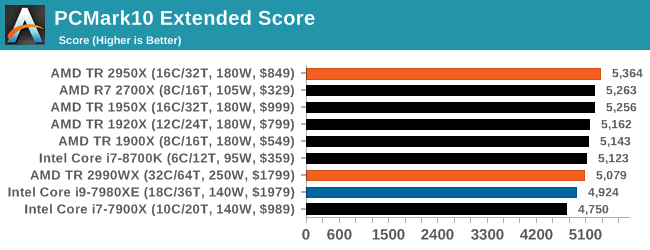
One of the downsides of PCMark is that it seems to bunch up all the results, showing them relatively close together, but interestingly here that the Intel processors sit near the bottom, with the 2950X and 2700X on the podium.
Chromium Compile: Windows VC++ Compile of Chrome 56
A large number of AnandTech readers are software engineers, looking at how the hardware they use performs. While compiling a Linux kernel is ‘standard’ for the reviewers who often compile, our test is a little more varied – we are using the windows instructions to compile Chrome, specifically a Chrome 56 build from March 2017, as that was when we built the test. Google quite handily gives instructions on how to compile with Windows, along with a 400k file download for the repo.
In our test, using Google’s instructions, we use the MSVC compiler and ninja developer tools to manage the compile. As you may expect, the benchmark is variably threaded, with a mix of DRAM requirements that benefit from faster caches. Data procured in our test is the time taken for the compile, which we convert into compiles per day.
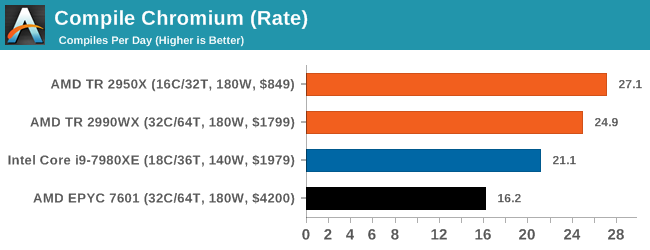
This test is such a nice mix of ST, MT, and memory limited flow that it is really interesting to see where the results end up. Unfortunately for our new suite the output files were not set up correctly, so despite running the test we only ever got a handful of results. But it shows an interesting metric: the 2950X sits ahead of the 2990WX, with both ahead of the Core i9, and the EPYC system being beaten handily due to its lower frequencies.
3DMark Physics: In-Game Physics Compute
Alongside PCMark is 3DMark, Futuremark’s (UL’s) gaming test suite. Each gaming tests consists of one or two GPU heavy scenes, along with a physics test that is indicative of when the test was written and the platform it is aimed at. The main overriding tests, in order of complexity, are Ice Storm, Cloud Gate, Sky Diver, Fire Strike, and Time Spy.
Some of the subtests offer variants, such as Ice Storm Unlimited, which is aimed at mobile platforms with an off-screen rendering, or Fire Strike Ultra which is aimed at high-end 4K systems with lots of the added features turned on. Time Spy also currently has an AVX-512 mode (which we may be using in the future).
For our tests, we report in Bench the results from every physics test, but for the sake of the review we keep it to the most demanding of each scene: Ice Storm Unlimited, Cloud Gate, Sky Diver, Fire Strike Ultra, and Time Spy.

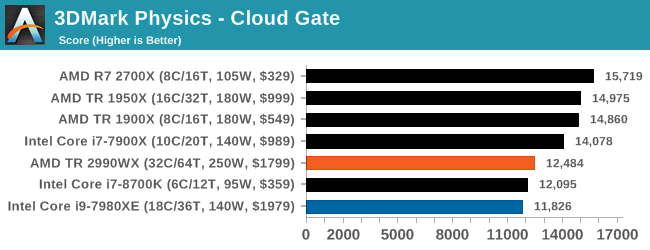

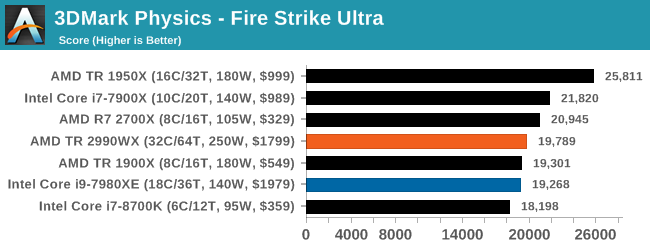
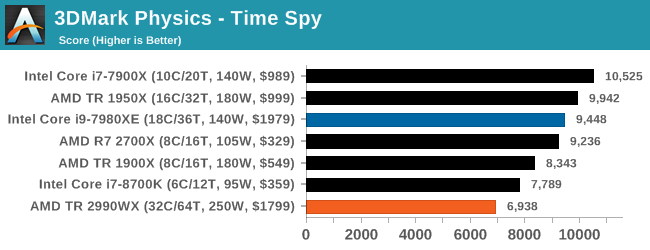
In the low end tests, it is clear that having these big processors doesn’t do much for performance, but even as we go up through Fire Strike and Time Spy, there seems to be a natural limit to the usefulness of these parts. Physics clearly loves having some extra memory bandwidth, and we know Time Spy isn’t meant to scale beyond about 10 cores, but we do see the 10 core processor sitting out front. Some of our testing sweeps had this benchmark configured incorrectly so it will be interesting to see how it fills out with some other mid and high core count processors.
GeekBench4: Synthetics
A common tool for cross-platform testing between mobile, PC, and Mac, GeekBench 4 is an ultimate exercise in synthetic testing across a range of algorithms looking for peak throughput. Tests include encryption, compression, fast fourier transform, memory operations, n-body physics, matrix operations, histogram manipulation, and HTML parsing.
I’m including this test due to popular demand, although the results do come across as overly synthetic, and a lot of users often put a lot of weight behind the test due to the fact that it is compiled across different platforms (although with different compilers).
We record the main subtest scores (Crypto, Integer, Floating Point, Memory) in our benchmark database, but for the review we post the overall single and multi-threaded results.












171 Comments
View All Comments
sjoukew - Thursday, August 16, 2018 - link
There is also an article which shows the difference in performance on windows vs linux for the Threadripper processors. It is amazing to see. https://www.phoronix.com/scan.php?page=article&...ishould - Monday, August 13, 2018 - link
TLDR; Unless you have a very specific need for 32 cores/2990WX, the 2950x is faster and cheaper than the former, even during tasks that traditionally scale well with cores. This is looking to be a good differentiator between Zen+ EPYC and 2990WX. Definitely looking forward to Zen+ EPYC tests!Silma - Monday, August 13, 2018 - link
"... it makes perfect sense for a narrow set of workloads where it toasts the competition."Can you please list those workloads?
When would it make sense to purchase a Threadripper PC vs many 'normal processors' PCs for tasks that you can easily handle in parallel?
Aephe - Monday, August 13, 2018 - link
For example people like me who use their computers for 3D rendering for one. (again: those Corona scores!) The more cores (and Ghz) + ram, the better!jospoortvliet - Saturday, August 18, 2018 - link
And linux/Unix use, like C++ or Rust developer. Or heavy vm user. https://www.phoronix.com/scan.php?page=article&...beggerking@yahoo.com - Monday, August 13, 2018 - link
I'm so glad the competition is back! its been stagnant for years now (at about 4 cores) with Intel dominating the market. For home labs/servers, this is great news! more cores for less without having to go the Xeon ES routes. :)j1ceasar@yahoo.com - Monday, August 13, 2018 - link
Can some one tell me who needs these, i don't as a normal consumercheshirster - Monday, August 13, 2018 - link
"tell me who needs these"As a normal customer you don't need to know this.
Gothmoth - Monday, August 13, 2018 - link
sorry but this handbrake numbers look wrong. no other website i have visited has seen such big differences.twtech - Monday, August 13, 2018 - link
I really would like to see some code compile benchmarks. Next to rendering and other graphic content related tasks, compiling code in large codebases is probably the 2nd most common use-case someone would consider buying a processor like this for, and it seems like there is a dearth of coverage for it.